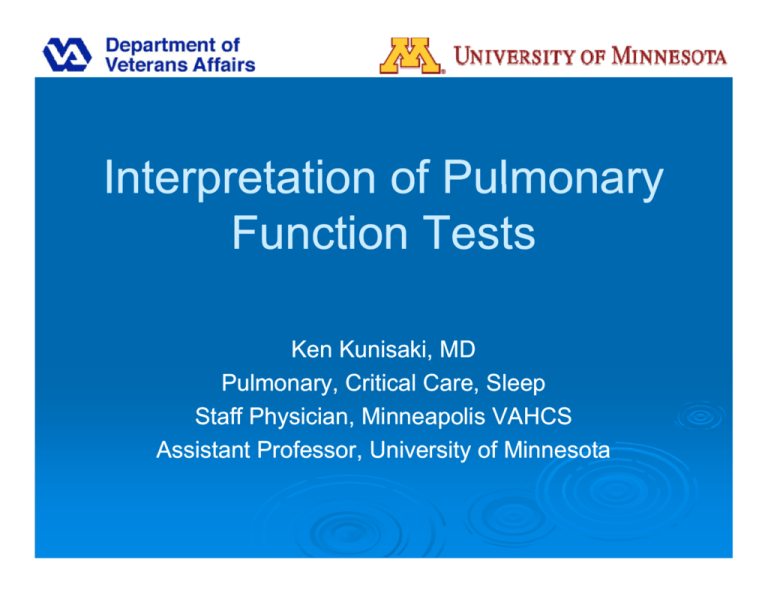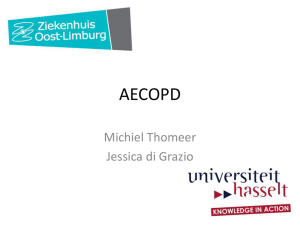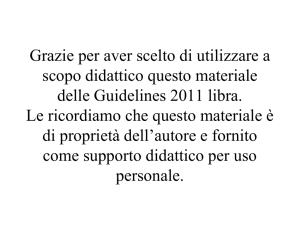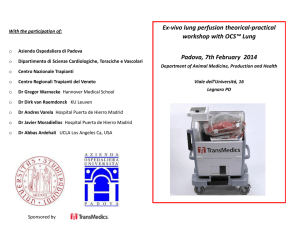Interpretation of Pulmonary Interpretation of Pulmonary Function Tests
advertisement

Interpretation of Pulmonary Function Tests Ken Kunisaki, MD Pulmonary, Critical Care, Sleep St ff Physician, Staff Ph i i Mi Minneapolis li VAHCS Assistant Professor, University of Minnesota Outline Indications Spirometry ATS/ERS criteria Interpretation and Limitations Lung Volumes Diffusing ff Capacity C Methacholine Challenge Overview Lung g function has both mechanical and g gas exchange g components PFT’s can quantify both PFT’ Mechanics: Spirometry, Lung volumes, Maximal pressures MVV pressures, Gas exchange: DLCO, (ABG) Gross composite: p 6MWD ((?P (?PFT FT’’s or not)) Detailed composite: CPET PFT Indications Diagnostic g Respiratory symptoms Screening highhigh-risk patients? Lung L resection ti surgery Lung transplantation evaluation Monitoring Response to therapy Natural history Occupational, Drug exposures Disability Assessment Epidemiologic Surveys/Research PFT CONTRAindications(?) Active pulmonary TB Recent pneumothorax? Recent R t MI MI, Unstable U t bl angina? i ? Recent chest, abdominal, eye surgery? Bronchodilator contraindications if doing post--bronchodilator post Spirometry Spirometry--Equipment Spirometry Volume measurements Fl Flow measurements t Measure volumes of at least 7 L with error of no more than 3% or 50 mL, whichever is greater, with flows of 00-12 Lps Measure flows of between -12 Lps and +12 Lps with error of no more than ±5%,, or 200 mL,, whichever is greater Appropriate scaling Equipment quality control Spirometry--Performance Spirometry Three phases of spirometry: Deep breath in Critical to FEV1 and FVC Easy to “fake fake”” Coaching g critical BLAST!!! Critical to FEV1 Keep going… Critical to FVC Spirometry--Performance Spirometry BEV <5% of FVC and <150mL Spirometry--Performance Spirometry Patient should be seated vs. standing? Nose clip is recommended Start of test Full inspiration with good expiratory effort Extrapolated volume does not exceed 5% of FVC or 150 mL, whichever is greater End of test Obvious plateau in volumevolume-time curve of at least 2 seconds Minimum exhalation time of 6 seconds, , but up p to 15 seconds Number of maneuvers Minimum of 3 and maximum of 8 Spirometry--Performance Spirometry Common “Acceptability Acceptability”” Issues Cough Early stop G t! Great! Poor effort Hesitant Start Spirometry--Performance Spirometry Largest and second largest FVC should differ by no more 150 mL Largest and second largest FEV1 should differ diff by b no more than th 150 mL L Spirometry--Performance Spirometry Spirometry--Performance Spirometry Spirometry--Interpretation Spirometry Trial 1 Trial2 Trial 3 FEV1 (L) 1.20 1.40 1.38 FVC (L) 2.70 2.67 2.71 FEV1/FVC 44% 52% 51% FEV1+FVC (L) 3.90 4.07 4.09 Acceptability criteria Yes Yes Yes The final report should be: FVC Ratio FEV1 a) 1.40 2.67 52% b) 1.38 2.71 51% c) 1.40 2.71 52% d) 1.33 2.69 51% e)) “Test T t does d nott meett ATS criteria— criteria it i —repeatt if clinically li i ll iindicated” indicated di t d” d” All of the following are included in spirometric prediction equations EXCEPT: a)) Age g b) Gender c) Height d) Weight e) Ethnicity Estimates of between subject variability FACTOR Age Sex Height Ethnicity Technical Unexplained p PROPORTION 0.30 0.08 0 08 0.20 0.10 0.03 0.29 Spirometry--Interpretation Spirometry Useful FEV1 FVC FEV1/FVC (calculated) ( l l t d) Not useful PEFR MEFR, MMF FEF75, FEF50, FEF25 Spirometry--Interpretation Spirometry Useful FEV1 FVC FEV1/FVC (calculated) ( l l t d) Not useful PEFR MEFR, MMF FEF75, FEF50, FEF25 Spirometry--Interpretation Spirometry Obstructive FEV1 Obstructive Restrictive Restrictive FVC FEV1/FVC Spirometry--Interpretation Spirometry Obstructive Definite • FEV1/FVC < LLN (GOLD states anything < 0.70) • FEV1 < predicted Example: 85 y/o Male Caucasian Predicted FEV1/FVC: 88.1 + (85 * -0.2066) =70.5% LLN FEV1/FVC: 78.4 + (85*(85*-0.2066) =60.4% 70.5 Example: 85 y/o Male Caucasian Predicted FEV1/FVC: 88.1 + (85 * -0.2066) =70.5% 60.4 LLN FEV1/FVC: 78.4 + (85*(85*-0.2066) =60.4% 84.5 Example: 35 y/o Female Mexican--American Mexican Predicted FEV1/FVC: =84.5% 75.2 LLN FEV1/FVC: =75.2% Spirometry--Interpretation Spirometry Obstructive Definite • FEV1/FVC < LLN (GOLD states anything < 0.70) • FEV1 < predicted Probable • FEV1/FVC < predicted • FEV1 < LLN Severityy • • • • Mild (FEV1 ≥ 80% predicted) Moderate (FEV1 ≥ 50% and < 80% predicted) Severe (FEV1 ≥ 30% and < 50% predicted) Very severe (FEV1 < 30% predicted) Spirometry--Interpretation Spirometry Restrictive High probability (TLC for “Definite Definite””) • FVC < LLN • FEV1/FVC > ULN Moderate probability • FVC < LLN • FEV1FVC > predicted Severity • • • • Mild (FVC ≥ 80% predicted) Moderate (FVC ≥ 50% and < 80% predicted) Severe (FVC ≥ 30% and < 50% predicted) Very severe (FVC < 30% predicted) Health Status and FEV1 Poor Health 100 80 SGRQ score r = - 0.23 0 23 p < 0.0001 60 40 20 Good Health Upper limit of normal 0 10 20 30 40 50 60 70 80 90 FEV1 (% predicted) Jones Thorax 2001; 56: 880 Bronchodilator Testing Patients with “irreversible disease” disease” by ATS criteria Irreversible 660 Reversible 385 287 213 74 275 98 48 Visit 1 58% irreversible 154 121 50 75 46 51 103 Calverley, PMA (ISOLDE Trial). Thorax 2003;58:659 Visit 2 62% i irreversible ibl Visit 3 59% irreversible Upper Airway Obstruction Fixed upper airway Variable extra-thoracic Variable intra-thoracic Quiz: The most common cause of a low FVC is: ____________. Lung Volumes Lung Volumes Helium dilution Nitrogen washout Less accurate in obstructive lung diseases— diseases—due to air (gas) trapping Plethysmography Lung Volumes Vital capacity Functional residual capacity Residual volume Normal Obstructive Restrictive Lung Volumes Restrictive Lung Disease: P leural A lveolar l l I interstitial N euromuscular (increased RV/TLC *boards alert!) T horacic Mixed ObstructiveObstructive-Restrictive (FEV1/FVC and TLC <LLN): Sarcoidosis Pulmonary Langerhans Cell Histiocytosis (Histocytosis X / Eosinophilic granuloma) Lymphangioleiomyomatosis y p g y (LAM) ( ) Hypersensitivity Pneumonitis (Silicosis, Berylliosis, Berylliosis, Others) Diffusing Capacity Diffusing Capacity Sensitive or Specific? C Causes off decreased d d DLCO: CO Anemia Emphysema p y ILD Pulmonary edema Pulmonary vascular disease Causes of increased DLCO: Ob it Obesity Asthma LR shunt Alveolar hemorrhage Methacholine Challenge Measures decrease in FEV1 in response to escalating doses of inhaled methacholine T ti procedure Testing d is i complex l Most patients with clinical diagnosis of asthma will have positive test Excellent sensitivity but many false positives (CHF, COPD, allergic rhinitis) May have useful applications, applications such as occupational screening Clinical applications are not well established (ATS St t Statement) t) Methacholine Challenge Categorization of bronchial responsiveness PC20 (mg/ml) Interpretation 16 Normal 4-16 Borderline BHR 1-4 Mild BHR <1 Moderate M d t to t severe BHR Methacholine Challenge Summary PFT standards are p published ((for PFT lab directors)) Spirometry most useful PFT Prediction equations have significant limitations Lung volumes if distinguishing obstruction from restriction clinically important Caution when interpreting “reversible airflow obstruction” obstruction” or “bronchial hyperhyper-reactivity” reactivity”. Boards: back back--extrapolated p volumes,, flowflow-volume loops, p , mixed obstructiveobstructive-restrictive diseases, causes of increased RV/TLC, causes of increased/decreased DLCO. DLCO Interpretation of Pulmonary Function Tests Ken Kunisaki, MD kunis001@umn.edu



